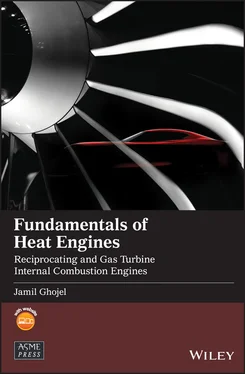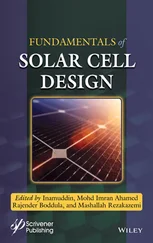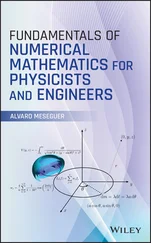(1.96) 
The values of  are usually calculated for different temperatures and can be found in tabular form as s 0= f ( T ) in most thermodynamic reference books. Using Eq. (1.96), we can write
are usually calculated for different temperatures and can be found in tabular form as s 0= f ( T ) in most thermodynamic reference books. Using Eq. (1.96), we can write
(1.97) 
Substituting Eq. (1.97) in Eq. (1.94), we obtain
(1.98) 
As Eq. (1.98) shows, entropy changes with both temperature and pressure. When using Eq. (1.98) in chemical reactions, the pressure ratio in the last term is replaced by the mole concentration of each substance.
The  data for some commonly used gases in heat engine practice such as CO 2, CO , H 2 O , H 2, O 2, and N 2are tabulated in Appendix A. They can be calculated to a very high degree of accuracy for the temperature range 100–6000 K by third‐order logarithm functions of the form
data for some commonly used gases in heat engine practice such as CO 2, CO , H 2 O , H 2, O 2, and N 2are tabulated in Appendix A. They can be calculated to a very high degree of accuracy for the temperature range 100–6000 K by third‐order logarithm functions of the form
(1.99) 
The coefficients of correlation Eq. (1.99) for six gases are given in Table 1.3.
Table 1.3Coefficients of Eq. (1.99) for the calculation of  of combustion products, p ref= 0.1 MPa T ref= 0 K .
of combustion products, p ref= 0.1 MPa T ref= 0 K .
|
 , kJ / kmole.K , kJ / kmole.K |
| Coefficient |
CO 2 |
CO |
H 2O |
H 2 |
O 2 |
N 2 |
| a |
269.772 6 |
234.929 1 |
233.305 3 |
166.044 4 |
243.729 9 |
228.592 9 |
| b |
53.720 45 |
33.106 85 |
42.087 92 |
30.813 48 |
34.405 98 |
32.655 06 |
| c |
4.955 586 |
1.661 032 |
4.707 912 |
2.022 13 |
2.175 759 |
1.661 282 |
| d |
−0.617 24 |
9.19E‐02 |
0.667 926 |
0.447 018 |
0.197 82 |
0.150 999 |
As for air, the following modified function (Rivkin 1987) can be used for the temperature range −50 to 1500 °C with the constant coefficients shown in Table 1.4:
(1.100) 
Table 1.4Coefficients of Eq. (1.100) for the calculation of  of air.
of air.
|
B n |
| A |
B 1 |
B 2 |
B 3 |
B 4 |
B 5 |
B 6 |
B 7 |
B 8 |
| 29.44 |
230.18 |
−1.61 |
−5.99 |
22.94 |
−24.56 |
12.98 |
−3.48 |
0.38 |
Finally, if the second law of thermodynamics can be stated as the law of degradation of energy , then entropy can be regarded as the measure of the degree of energy degradation.
Problems
Engineering Mechanics
1 1.1 Determine the velocity required to keep satellite P in orbit at altitude S km above the surface of the earth. Force F2 is the balancing force that keeps the satellite in circular orbit. The gravitational force acting on the satellite, treated as a particle, is
2 1.2 A crank‐slider has a crank radius R = 100 mm, a connecting rod length L = 200 mm, and a crank angular speed ω = 100 rpm counterclockwise.Write the expressions for the displacement x and velocity of piston PDetermine the velocity when θ = 450.
3 1.3 Determine the moment of inertia and radius of gyration about an axis through the centre of a composite body with a central inner disk of mass 4 kg and radius 300 mm and a ring of mass 5 kg and radius 400 mm. The masses of the four spokes shown can be ignored.
4 1.4 A constant torque of 150 Nm applied to a turbine rotor is sufficient to overcome the constant bearing friction torque and give it a speed of 75 rpm from rest after 9 revolutions. When the 150 Nm torque is removed, the turbine rotor turns for a further 23 revolutions before stopping. Determine the moment of inertia of the rotor and the bearing friction torque.
5 1.5 A motor is required to reach an operating speed of 500 rpm in a time of 30 seconds from rest at a constant acceleration. DetermineThe required constant accelerationThe number of revolutions the motor turns to reach this operating speed. The motor is then turned off and comes to rest under a constant deceleration of 0.1 rad/s2 due to bearing friction. How long and how many revolutions does it take for the motor to come to reset?
1 1.6 The following nondimensional parameters are suggested for graphical representation of compressor characteristics:where is the mass flow rate, R is the gas constant, T is the gas temperature, D is the impeller diameter, and p is the gas pressure. Verify whether these parameters are truly nondimensional. If they are not, suggest a corrected form of the parameters.
2 1.7 Dimensional analysis has identified the following function for the pressure loss in a pipe:whereCheck if these two groups are nondimensional, and suggest remedies if they are not.Determine the actual correlation for flow of water in a 1500 mm long pipe with 12.5 mm diameter using experiments conducted at 20 °C with the following results:C, m/s0.3750.5940.8871.7803.3925.1577.1148.757Δp, Pa3007471 4805 07515 75332 60657 45682 832The water is at 20 °C, the density ρ = 998.2 kg/m3, and the dynamic viscosity is
3 1.8 Air is drawn into engine cylinder as the piston moves away from top dead centre (TDC) during the induction stroke, as shown in the following figure. Determine the pressure drop in the induction manifold for these conditions:Ambient pressure pa = 0.1 MPa.Flow velocity at the inlet Ca is negligible, and at the valve throat C = 56 m/s.Loss head at the valve restriction is given by hloss = βC2/2g, where the loss factor β = 7.Density of air ρa = 1.21 kg/m3. (Due to the small pressure drop during the induction process, air can be treated as incompressible fluid.)
4 1.9 In a frictionless cylinder and piston device, the piston is forced against a gas by a spring, which exerts a force directly proportional to the gas volume. In addition, the atmospheric pressure of 101.3 kPa acts on the outer face of the piston.Considering the gas as a system, calculate the work for the process from an initial state of 0.2 MPa, 0.1 m3 to final volume of 0.3 m3.If the spring is taken as a system, find the work for the same process.Explain the difference in work terms for the two systems in (a) and (b).
Читать дальше


 are usually calculated for different temperatures and can be found in tabular form as s 0= f ( T ) in most thermodynamic reference books. Using Eq. (1.96), we can write
are usually calculated for different temperatures and can be found in tabular form as s 0= f ( T ) in most thermodynamic reference books. Using Eq. (1.96), we can write

 data for some commonly used gases in heat engine practice such as CO 2, CO , H 2 O , H 2, O 2, and N 2are tabulated in Appendix A. They can be calculated to a very high degree of accuracy for the temperature range 100–6000 K by third‐order logarithm functions of the form
data for some commonly used gases in heat engine practice such as CO 2, CO , H 2 O , H 2, O 2, and N 2are tabulated in Appendix A. They can be calculated to a very high degree of accuracy for the temperature range 100–6000 K by third‐order logarithm functions of the form
 of combustion products, p ref= 0.1 MPa T ref= 0 K .
of combustion products, p ref= 0.1 MPa T ref= 0 K . , kJ / kmole.K
, kJ / kmole.K
 of air.
of air.








